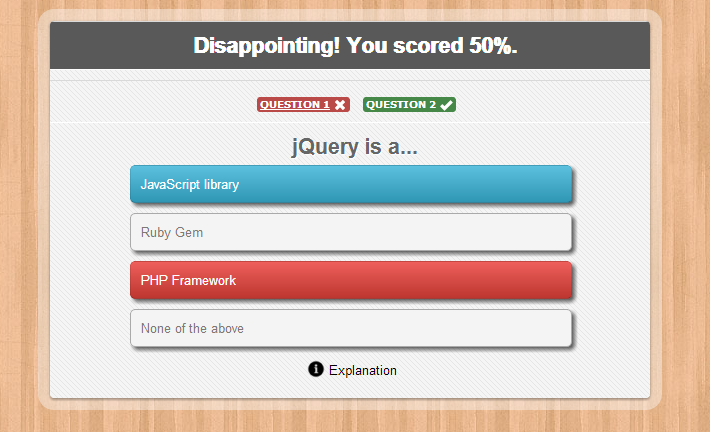
Blog Comment Thing
Underneath most blog posts is an area for visitors to leave a comment about each post. Blog comments are a critical part of a successful blog, and an area bloggers must understand and focus on to create a great blog.
Blog comments are what make a blog interactive and social. The most popular blogs have a very interactive community who voice their opinions on posts frequently.
It’s that social aspect that makes blogs such a powerful component of the social web. People like to feel involved. Leaving blog comments allows readers to join in on the conversation about a topic that interests them.
Blog comments are the lifeblood of a blog. Comments are what separates a blog from a static website. As the conversation builds, so will your relationship with your readers and so will your blog’s popularity.
Encourage your readers to join in the discussion and leave comments and respond promptly to the comments left by your readers to make them feel valued. Just as you don’t like to be ignored when you address someone in person, you don’t want to ignore your readers when they address you through a blog comment.
Problems
One of the biggest worries bloggers have is the silent blog syndrome. After putting endless hours of hard work into your blog, you find that it remains silent. No one comments. No one argues. No one praises. It’s a dark and lonely place.
How do you get people to comment on your blog? What tricks, techniques, and powers of persuasion must you possess? A quiet blog can be depressing, while an active blog is exciting. Once people start chiming in, sharing tips, arguing points, and having a conversation, you feel as if your blogging existence has finally been validated.
Commenting on a blog is something that your readers do voluntarily.They choose to do it because they want to. And what prompts their volition? Really outstanding content. It can be outstandingly good. It can be outstandingly bad. It can be outstandingly controversial. It just needs to be outstanding. Create outstanding content before thinking, “How can I get people to comment?”
In addition to that, commenting is really about marketing. If there is no one to read a blog, there will be no comments. If you want blog commenting, you also have to do blog marketing.
Now that we got that out of the way, let’s dive into your blog and figure out why you’re not getting comments.
- Do you have a bad comment system?
- Do you have a poor site design?
- Do you blog as a corporate entity?
- Do you say anything original?
- Do you have a boring writing style?
- Do you ignore interaction?
- Do you ask for comments?
- Do you provide something of value in your writing?
- Do you write anything really compelling?
- Do you ever get controversial?
If all the answers are YES, then we really have to deal with it!
Techniques
One of the best ways to gauge the health of your blog readership is to check out how many comments you have for your posts. More comments mean that your readers are actively engaged in what you have to say. Such positive engagement between the readers and yourself creates a lively community that sustains readership and attracts more visitors to your blog.
Here are a few ways to get your readers more involved before you scrutinize your content for any potential flaws.
End with a Question
Sometimes readers don’t know what to comment about. Posting a question about your post will give them an anchor point to what they can talk about. Intuitively speaking, we should place that question right at the end of the post. If your reader has read from the beginning to the end and got to that point, chances are that he or she is interested in what you’ve written. The reader will be pretty motivated to answer your question.
Ask for Contributions
Another way you can ask for more comments is to get them to contribute to your seemingly incomplete post. This is especially applicable to posts where you organized your content in the form of a numbered list (just like this one). Now, the trick here is to ask your readers to add on to the list. Make them feel that they are contributing to the article by merely commenting their opinion.
Reply to Comments Promptly
Basic courtesy dictates that when someone gives a certain feedback about one’s work, one should, at the very least, thank him or her. If your reader has a question posed to you, all the more you should answer promptly. This will let your reader feel that his or her comments matter, and that he or she isn’t talking to him or herself.
Reward Insightful Comments
Simply replying when being commented on isn’t enough; sometimes you need a carrot to motivate them to type out what they think. It can be any forms of reward: a contest for the best comment posted, prizes for answering correctly a question posed, or perhaps the promise of writing the next post based on the most interesting comment.
Reduce Barriers to Commenting
Is there anything that might be hindering your readers from posting comments? Do a check yourself and try to post something yourself. Does it go through smoothly? Also, is the comment box easily noticed once you enter the blog as a visitor? The other thing to look out for is whether visitors to your blog need to register or log in before they can comment on your posts. If this is so, this might be the reason why you’re getting so few comments. Taking that extra step to register in order to comment can be a big turn-off for some readers, so they would rather hold their peace forever.
Commenting on Posts in the Blog Community
If you want people to comment, then set a good example yourself! Comment in your own blog and other similar topic blogs in the community. Ensure that you give well thought out comments that relate to the topic in question instead of one-liner generic answers (e.g. “Great Post!”). This is especially so when you comment on other blogs and leave a link to your site.
Shake Things Up a Little
The last point here has something to do with your content. A discussion arises when there is a common goal to work to (e.g. providing suggestion for that last tip in your numbered list) or when there are conflicting opinions. All you need to do is to make your content a little controversial or take sides with a particular opinion of yours.
Types
Here are seven types of blog comments and how to respond to them:
1. The Spammer
This commenter enters 50 links to “London Escorts” services and dog food sales. These comments are the easiest to respond to: Use Akismet and forget about them.
2. The Long-Winded
This person writes really, really long comments. 200 words is a long blog comment. 500 words is beyond long. 1000 words or more is epic. But you occasionally get those.
Generally, these comments are from people who are new to the blogging world and don’t know about the unspoken rule that comments should be short and sweet (50 words is pushing the comment length limit).
How to deal with them?
First, be gentle. Remember, these are generally (but not always) people who are new to the blogging world.
Second, congratulate them on their well-thought out comment. Tell them they raise good points and clearly have something to say. Invite them (nicely) to start their own blog to say it. If they already have a blog, tell them that their comment would make a great response post.
This is not only tactful, but wise, as it’s a great way to get an inbound link to your site.
3. The Nonsensical
You read their comment, and the first thing you say is, “Uhh. What?” The words form a sentence, but not one that makes any sense.
How do you respond to such comments? With exactly what went through your head: “Uhh. What?” Sometimes, they will return and clarify. Most often not, in which case, they might have actually been spammers that sneaked through Akismet.
4. The Non-Reader
This person clearly didn’t read anything past the title. Bloggers often write controversial titles in order to get people to read the post, but sometimes people respond to the title, rather than to the actual content.
All you can do is laugh, and tell them to read the post. The truth is, if they didn’t take the time to read it the first time, they probably won’t check back to see if you responded to their comment.
5. The Self-Promoter
This person has one agenda: to promote their own blog. They make some loose connection to your post with something they wrote on their blog, and then post a link to it.
How should you respond? Truthfully, I don’t mind this so much. Blogging requires a little self-promotion every now and then. There are subtle ways of promoting your blog besides posting a link inside a comment, but if that’s the way some roll, so be it.
I usually respond with a generic “Thanks for the link. I’ll check it out!” and then, I actually do, leaving a comment with a link to my post. Turnabout’s fair play.
6. The Generic
I don’t really understand these comments. The person will say something like “Interesting post! Thanks for writing it.”
Maybe this type of commenter is self-promoting through the link that is attached to their name, or maybe they are a non-reader, or maybe they just visit a thousand blogs a day and post the same comment, in which case they are a spammer.
I used to delete these generic comments, but found that many of them checked back on the post, saw their comment was deleted, and then sent me an email asking why. So I no longer do that.
Instead, the best way to respond to a generic comment is with a generic reply. “Thanks for reading!” is sufficient.
7. The Truly Interested
These are the best and deserve your full and careful attention. The comment is 100 words or less, and shows true interaction with the content of your post. They either add to the idea, or ask a thoughtful question.
You should respond in kind. Reward these commenters with a weekly or monthly “Top commenters” post, or a widget on the sidebar showing top commenters. They deserve to get some love from your blog for the comments they post.
These commenters drive your blog traffic. Treat them like the royalty they are. Visit their blogs, leave comments, and subscribe.
There are so many advantages to an active blog. You generate excitement, get engagement, elicit feedback, establish authority, invite backlinks, and get extra SEO juice.
It’s a beautiful thing. All you have to do is get rid of the barriers to comments and produce the best content you possibly can.








